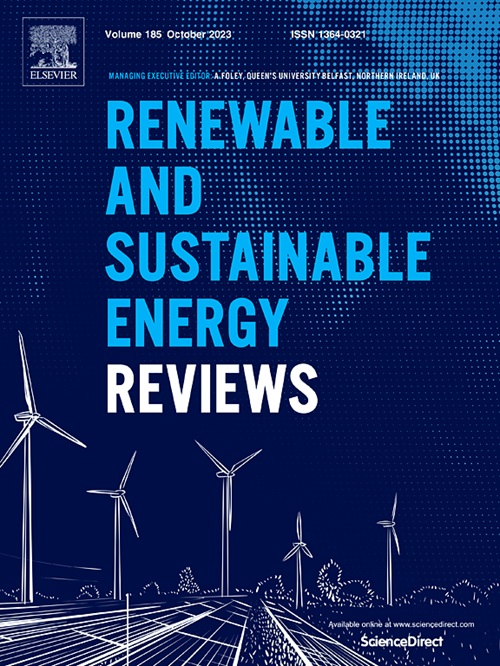质子交换膜水电解槽的研究进展:传热传质研究进展
IF 16.3
1区 工程技术
Q1 ENERGY & FUELS
引用次数: 0
摘要
质子交换膜水电解槽(PEMWEs)对于绿色制氢至关重要,但由于传热传质耦合的挑战,其性能受到限制。在高电流密度下,氧泡积聚在阳极多孔输运层(PTL)和流道中,阻止水进入催化位点并引起浓度极化。优化PTL孔隙结构和表面润湿性,减少气泡粘附,提高除氧能力。先进的流场设计通过平衡对流和压降进一步增强气液分离。热管理同样至关重要。氧的低导热率导致ptl -催化剂界面出现热点,加速了膜的降解。提高导热系数,优化通道几何形状,并应用主动冷却策略可以减轻热应力。温度和压力的动态控制至关重要,因为较高的温度会改善动力学,但会促进气泡的生长,而适度的压力会降低气泡的尺寸,但代价是密封的复杂性。多尺度模拟和成像提供了对气泡动力学的深入了解,但在完全解决多物理场耦合、优化材料结构协同以及适应波动的可再生输入方面仍然存在挑战。未来的研究应探索跨尺度耦合电化学和流动模型、多结构优化以及流体动力学和机器学习等跨学科方法等方法,以有效调节传热传质,推进可扩展、耐用的PEMWE系统。本文章由计算机程序翻译,如有差异,请以英文原文为准。
A review on proton exchange membrane water electrolyzer: advances in heat and mass transport
Proton exchange membrane water electrolyzers (PEMWEs) are vital for green hydrogen production but face performance limitations due to coupled heat and mass transfer challenges. At high current densities, oxygen bubbles accumulate in the anode porous transport layer (PTL) and flow channels, blocking water access to catalytic sites and causing concentration polarization. Optimizing PTL pore structure and surface wettability reduces bubble adhesion and improves oxygen removal. Advanced flow field designs further enhance gas-liquid separation by balancing convection and pressure drop. Thermal management is equally critical. The low thermal conductivity of oxygen leads to hot spots at the PTL–catalyst interface, accelerating membrane degradation. Enhancing thermal conductivity, optimizing channel geometry, and applying active cooling strategies can mitigate thermal stress. Dynamic control of temperature and pressure is essential, as higher temperatures improve kinetics but promote bubble growth, while moderate pressure reduces bubble size at the cost of sealing complexity. Multiscale simulations and imaging provide insight into bubble dynamics, but challenges remain in fully resolving multi-physics coupling, optimizing material–structure synergy, and adapting to fluctuating renewable inputs. Future research should explore approaches such as coupling electrochemical and flow models across scales, multi-structure optimization, and interdisciplinary methods like fluid dynamics and machine learning, to effectively regulate heat and mass transfer and advance scalable, durable PEMWE systems.
求助全文
通过发布文献求助,成功后即可免费获取论文全文。
去求助
来源期刊

Renewable and Sustainable Energy Reviews
工程技术-能源与燃料
CiteScore
31.20
自引率
5.70%
发文量
1055
审稿时长
62 days
期刊介绍:
The mission of Renewable and Sustainable Energy Reviews is to disseminate the most compelling and pertinent critical insights in renewable and sustainable energy, fostering collaboration among the research community, private sector, and policy and decision makers. The journal aims to exchange challenges, solutions, innovative concepts, and technologies, contributing to sustainable development, the transition to a low-carbon future, and the attainment of emissions targets outlined by the United Nations Framework Convention on Climate Change.
Renewable and Sustainable Energy Reviews publishes a diverse range of content, including review papers, original research, case studies, and analyses of new technologies, all featuring a substantial review component such as critique, comparison, or analysis. Introducing a distinctive paper type, Expert Insights, the journal presents commissioned mini-reviews authored by field leaders, addressing topics of significant interest. Case studies undergo consideration only if they showcase the work's applicability to other regions or contribute valuable insights to the broader field of renewable and sustainable energy. Notably, a bibliographic or literature review lacking critical analysis is deemed unsuitable for publication.
 求助内容:
求助内容: 应助结果提醒方式:
应助结果提醒方式:


